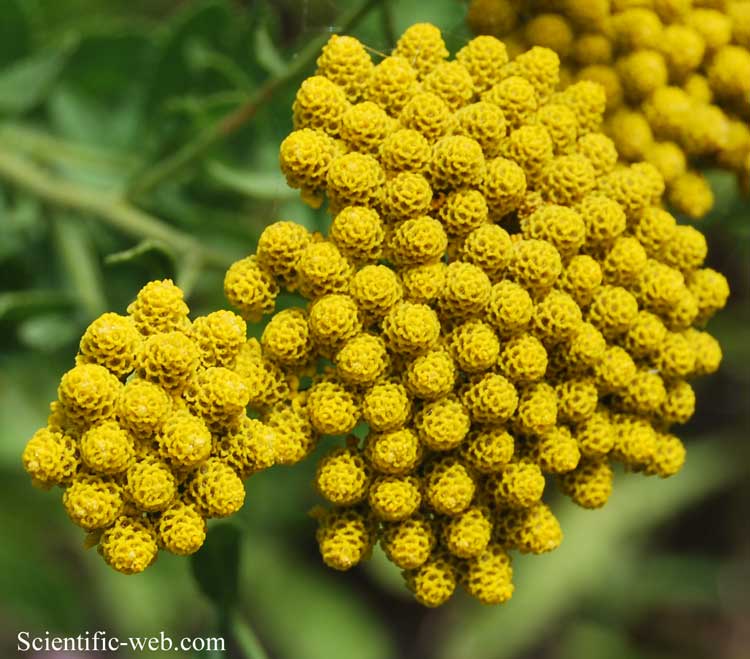
Achillea ageratum, Photo: Michael Lahanas
Classification System: APG IV
Superregnum: Eukaryota
Regnum: Plantae
Cladus: Angiosperms
Cladus: Eudicots
Cladus: Core eudicots
Cladus: Asterids
Cladus: Campanulids
Ordo: Asterales
Familia: Asteraceae
Subfamilia: Asteroideae
Tribus: Anthemideae
Subtribus: Matricariinae
Genus: Achillea
Sectio: A. sect. Achillea
Species: Achillea ageratum
Name
Achillea ageratum L., Sp. Pl. 2: 897 (1753).
Synonyms
Homotypic
Achillea viscosa Lam., Fl. Fr., 2: 156 (1779), nom. illeg.
Conforata ageratum (L.) Fourr., Ann. Soc. Linn. Lyon, sér. 2, 17: 91 (1869).
Santolina ageratum (L.) Baill., Hist. Pl., 8: 311 (1882).
Distribution
Native distribution areas:
Continental: Europe
Regional: Northern Europe
Great Britain (alien).
Regional: Middle Europe
Belgium, Germany (casual).
Regional: Southwestern Europe
Baleares (Ibiza & Formentera, Mallorca), Corse, France, Portugal, Sardegna, Spain.
Regional: Southeastern Europe
Greece (doubtful), Italy, Romania (alien), Yugoslavia (Croatia).
Continental: Africa
Regional: Northern Africa
Morocco
Regional: Macaronesia
Madeira (large-scale cultivation).
References: Brummitt, R.K. 2001. TDWG – World Geographical Scheme for Recording Plant Distributions, 2nd Edition
References
Linnaeus, C. 1753. Species Plantarum. Tomus II: 897. Reference page.
Links
International Plant Names Index. 2017. Achillea ageratum. Published online. Accessed: Nov. 26 2017.
Tropicos.org 2017. Achillea ageratum. Missouri Botanical Garden. Published online. Accessed: 26 Nov. 2017.
Hassler, M. 2017. Achillea ageratum. World Plants: Synonymic Checklists of the Vascular Plants of the World In: Roskovh, Y., Abucay, L., Orrell, T., Nicolson, D., Bailly, N., Kirk, P., Bourgoin, T., DeWalt, R.E., Decock, W., De Wever, A., Nieukerken, E. van, Zarucchi, J. & Penev, L., eds. 2017. Species 2000 & ITIS Catalogue of Life. Published online. Accessed: 2017 Nov 26. Reference page.
Govaerts, R. et al. 2021. Achillea ageratum in Kew Science Plants of the World online. The Board of Trustees of the Royal Botanic Gardens, Kew. Published online. Accessed: 2021 Apr 17. Reference page.
Vernacular names
Deutsch: Leberbalsam-Schafgarbe
français: Achillée à feuilles d'agératum
Türkçe: Tatlı civanperçemi
Achillea ageratum, also known as sweet yarrow,[2] sweet-Nancy,[3] English mace or sweet maudlin, is a flowering plant in the sunflower family, native to Europe (Portugal, Spain, France, England, Belgium, Germany, Italy, Croatia and Romania), and Morocco.[4] In the United States the plant is cultivated in the state of New York for its pleasant fragrance and sparingly naturalized in a few places outside its native range.[5][6]
In the Middle Ages it was used as a strewing herb to repel insects such as moths, lice and ticks and spread a good smell in private rooms.[7] The leaves of English mace can be chopped and used raw as a herb, or added with other herbs to soups and stews.[8]
References
The Plant List Achillea ageratum L.
BSBI List 2007 (xls). Botanical Society of Britain and Ireland. Archived from the original (xls) on 2015-06-26. Retrieved 2014-10-17.
USDA, NRCS (n.d.). "Achillea ageratum". The PLANTS Database (plants.usda.gov). Greensboro, North Carolina: National Plant Data Team. Retrieved 7 January 2016.
"Achillea ageratum L." Catalogue of Life. Retrieved 16 December 2020.
Biota of North America Program 2014 county distribution map
"Achillea ageratum L." Plants of the World Online. Royal Botanic Gardens, Kew. Retrieved 19 November 2021.
Bailey & Bailey 1976, p. 17.
Farrell 2019, p. 24.
Sources
Bailey, Liberty Hyde; Bailey, Ethel Zoe (1976). Hortus Third: a concise dictionary of plants cultivated in the United States and Canada. New York: Macmillan. ISBN 978-00250-5-470-7 – via Internet Archive.
Farrell, Holly (2019). The Kew Gardener's Guide to Growing Herbs. London: White Lion Publishing. ISBN 978-07112-3-936-4.
Retrieved from "http://en.wikipedia.org/"
All text is available under the terms of the GNU Free Documentation License

